What App Does The Odd Ones Out Use To Draw
How you take notes is a very personal thing. Do you carefully sub-head, section, and bullet, or quickly scrawl things down anywhere? Are you text-only, or do you use more of a scrapbook system? And how do you index and find old notes? Whatever your approach, there are some great digital note-taking apps out there that can accommodate all your quirks and note-related fancies.
Turn ideas into action
Now, one big thing to note. You can write notes on anything: the back of a napkin, an envelope, a ticket stub, and, yes, a notebook. It's the same with apps: you can write notes in a writing app like Ulysses or throw them in a Google Doc or Gmail draft; you can use empty text files or even a sticky notes app. For this list, we weren't interested in apps that could be used as notes apps—we only wanted apps that were explicitly designed to be used as notes apps. This might have excluded the app you personally use, but without this requirement in place, we'd have to consider whether Excel or Google Sheets was more efficient for taking notes. (The answer is they're both awful.)
We also excluded super-niche notes apps, like those designed for fiction writers or developers. Great note-taking apps should be suitable for lots of different purposes and people, not just a small subset of a small subset. Even with these criteria in place, we still looked at close to 40 different apps. Here are our favorites.
The best note-taking apps
-
Evernote for the ultimate digital notebook
-
Microsoft OneNote for a free note-taking app
-
Apple Notes for Apple users
-
Google Keep for Google power users
-
Notion for collaboration
What makes a great note-taking app?
With so many apps to consider, we had some pretty strict criteria for what made a great notes app.
-
First, the apps had to do what they set out to do, and do it well. Not every note-taking app needs to have image-to-text features or support styluses, but if it boasted about them, they'd better be good. There are so many different ways to use digital notes that what one person considers essential can just clutter up the interface to another.
-
Second, note-taking apps had to be quick and easy to use. A pen and scrap of paper are hard to beat for speed and convenience, but any note-taking app has to get out of your way. Creating, editing, and sorting notes needed to be something that felt seamless and natural, rather than a battle with a horrible user interface. If you couldn't create a new note in seconds or needed to jump through weird hoops to grab different tools, the app wasn't making our list.
-
Similarly, your notebook is something that needs to be always available, whether you're at your desk or midair flying coast-to-coast. At a minimum, we needed apps to be available on one desktop and one mobile platform, and to have some kind of offline functionality. Your access to your notebook couldn't be cut off because you didn't have Wi-Fi.
-
Finally, we required apps to be good value for money. Free is, of course, wonderful, but that does have to be balanced against the likelihood of the service surviving the next few years and the availability of server-based features like syncing. Some of the best apps charge a reasonable subscription price and, as long as they justified the pricing, that was no barrier to inclusion.
Best note-taking app for the ultimate digital notebook
Evernote (Android, iOS, macOS, Windows, Web)
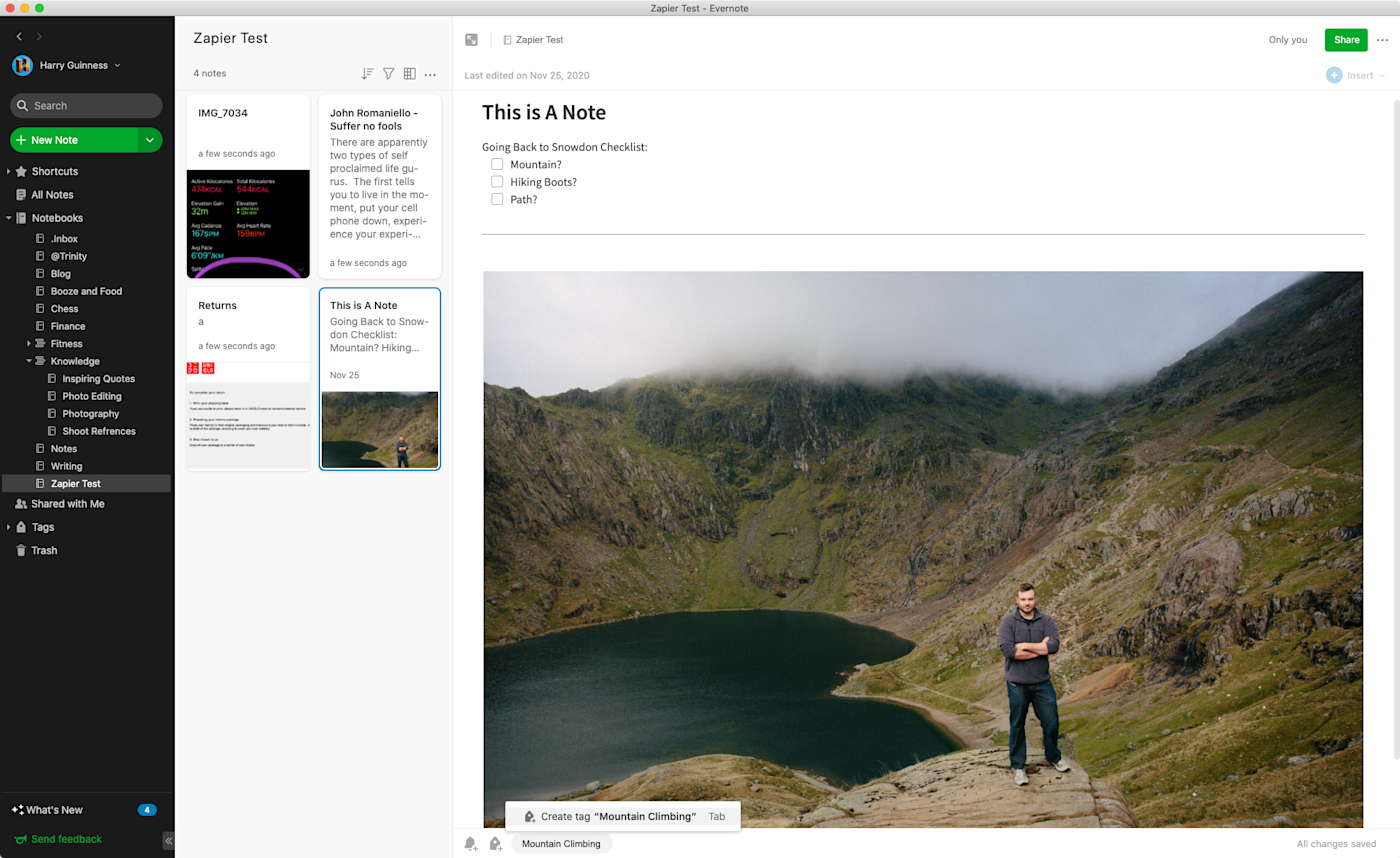
It's impossible to talk about note-taking apps without mentioning Evernote, so it should be no surprise to see it on this list. It's one of the most powerful options around and can handle notes in almost any format you want. You can add text notes, audio clips, images, PDF documents, scanned hand-written pages, Slack conversations, emails, websites, and anything else you can think of. If you're the kind of person who's as likely to scribble the outline to a best-seller on the back of a napkin as you are to save your shopping list as a voice memo, Evernote is great: it gives you one safe place to throw everything.
But Evernote isn't just a dumping ground. It's designed so you can easily sort and organize your notes. Create a new note by clicking New Note, type whatever you want or add any of the supported note types, then, at the bottom of the screen, you can add tags. If you already have some tags set up, they'll be auto-suggested; otherwise, you can type whatever you want and hit Enter. In the sidebar, click Tags to see a searchable list of every tag you've used. It's a really fast way to sort notes as you create them, without having to worry about putting every note perfectly in its place.
Of course, later on you can dive back in and arrange all your notes into meticulously sorted notebooks. In that case, click Notebooks in the sidebar and then New Notebook. Give it a name and you'll be able to drag and drop notes from anywhere else in Evernote into it. Alternatively, you can right-click on a note, click Move to, and then select your chosen notebook.
Evernote takes things a step further with its search functionality. If you upload an image of a sheet of paper, a business card, a menu, a sign, or anything else with text, Evernote automatically processes the image to make it more readable—and then processes the text to make it searchable. So, if you add a photo of your favorite pancake recipe, you'll be able to search for it as if it's a text note you typed yourself. Evernote even works with handwritten notes, though with the huge caveat that your writing must be neat enough that a computer can read it. (Mine, sadly, is not.)
It's similar with PDFs and other documents you upload—if you have a Premium Evernote subscription, the text is searchable throughout the app.
Crucially, that $7.99/month Premium Evernote subscription needs to be mentioned. Evernote's free plan doesn't make this list. It's limited to two devices, and you can't save notes for offline access on mobile. There are better, or at least almost as good but less limited, free options available. However, if you're looking for the ultimate everything notebook and don't mind the monthly fee, then Evernote is easily the app for you.
Evernote integrates with Zapier, letting you automate your note-taking. For example, you can automatically create tasks from Evernote reminders, or create new notes for calendar events.
Evernote Price: Very limited free plan; $7.99/month for Evernote Premium with unlimited devices and offline mobile access.
Best free note-taking app
Microsoft OneNote (iOS, Android, macOS, Windows, Web)
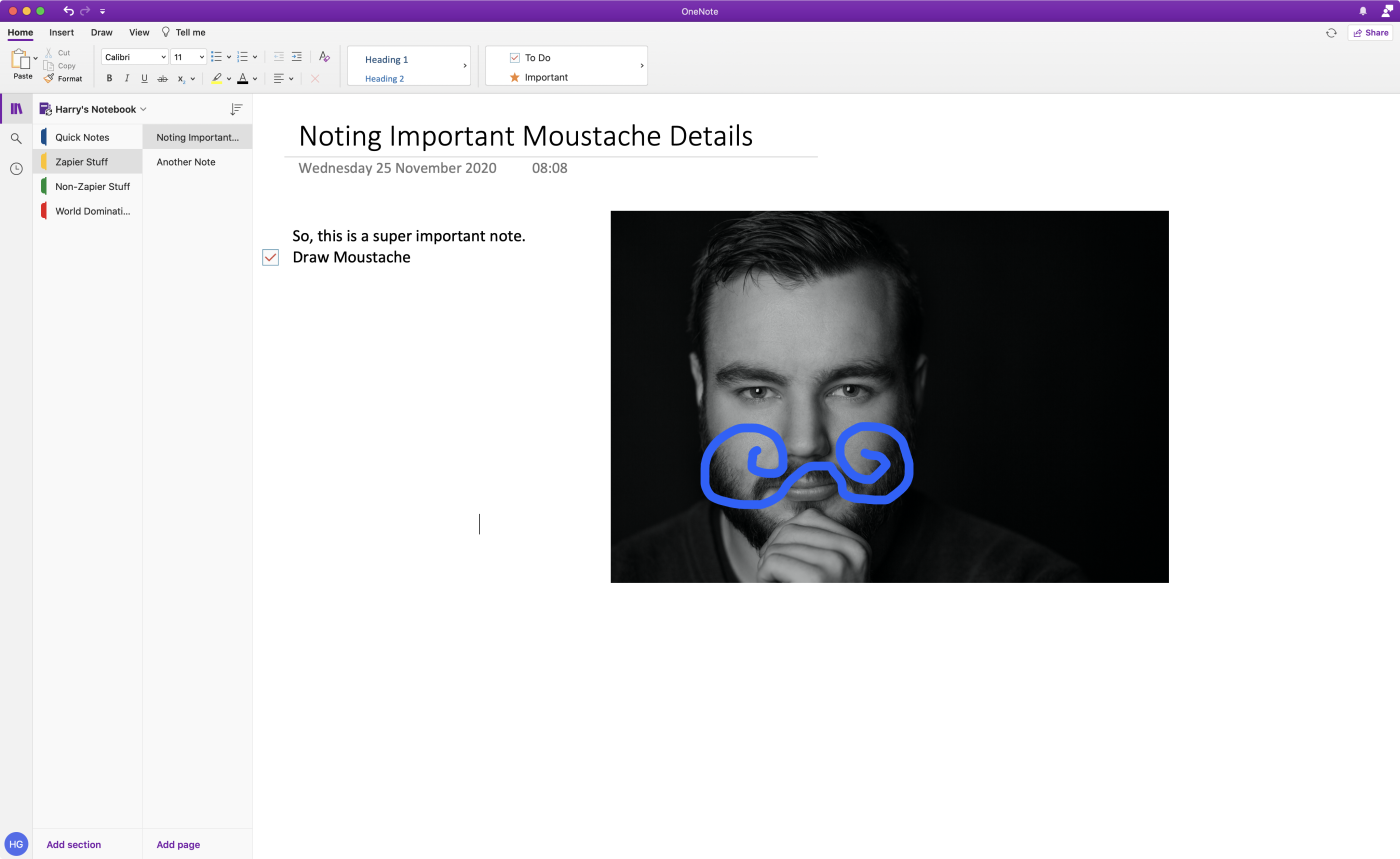
Microsoft OneNote is a free and full-featured note-taking app. It's Microsoft's answer to Evernote, though without the need for a monthly subscription. Though, of course, there are other differences.
One big one is that OneNote is a lot more freeform. Each Notebook is modeled off a ringbinder, so it's divided into Sections with subsections called Pages. And each Page is basically a freeform canvas where you can add any kind of note you like, anywhere you want. This means you can drag and drop in an image, click anywhere to add some text notes beside it, and if your computer supports a stylus, scribble a mustache on everyone in the photo. (Otherwise you can draw one on with your trackpad, but it'll be less stylish.) It feels like a solution purpose-built for students and anyone else who has to take long, discursive notes about something, rather than people looking for a digital notebook to collect short snippets and random ideas.
I'd struggle to call any of Microsoft's apps intuitive, but OneNote is familiar. The ribbon at the top of the app has five tabs: Home, which has all the basic formatting tools; Insert, which lets you attach files, images, audio recordings, and everything else; Draw, which gives you all the free drawing and highlighting tools; View, which lets you navigate the document and change how things look; and, finally, Tell Me, which is the help function. If you've used any version of Word, Excel, or PowerPoint in the last decade, you'll be right at home.
In terms of pricing, although OneNote is free, it uses your OneDrive storage. You get 5GB included, which is more than enough for most people. But if you use OneDrive to store your photos, or save a lot of image and audio notes over a four-year university degree, you might hit against that limit. If you do, you can increase it to 100GB for $1.99/month.
With OneNote's Zapier integration, you can automate OneNote to eliminate the hassle of moving information between apps. For example, Zapier can automatically create new notes in OneNote whenever you have a new task, note, or calendar event in another app.
OneNote Price: Free for up to 5GB of notes; $1.99/month for 100GB.
Evernote and OneNote are the frontrunners in the note-taking category. Take a look at how they stack up in our Evernote vs. OneNote showdown.
Best note-taking app for Apple users
Apple Notes (iOS, macOS, Web)
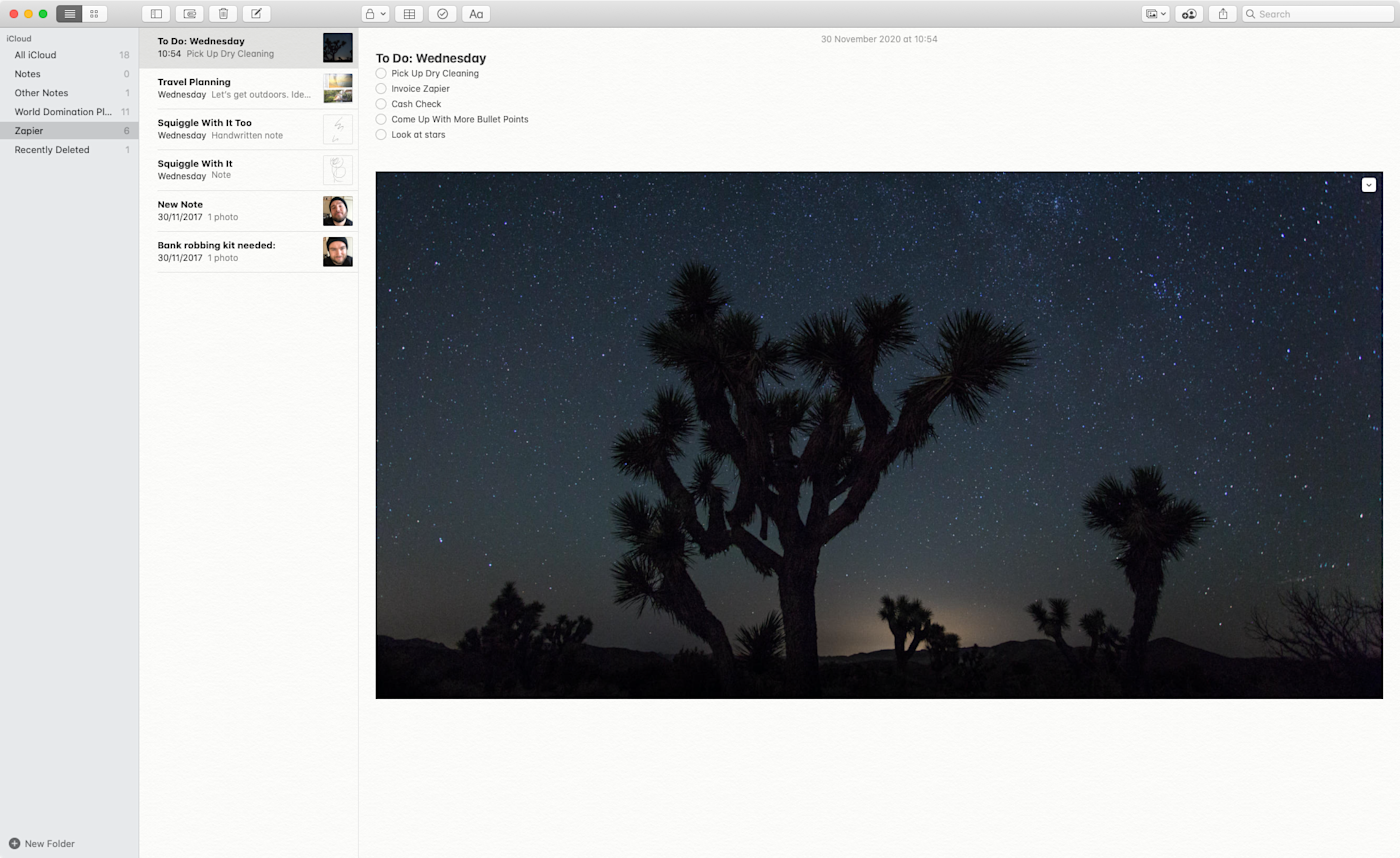
If you're firmly entrenched in Apple's ecosystem, you don't have to look too far for a great, free note-taking app. Apple Notes (variously called Notes or iCloud Notes, depending on how you're accessing it) is built into macOS and iOS, and can also be used through your browser. Just head to icloud.com/notes, and you get an online, albeit stripped down, version of the Mac app with all your synced notes—even if you're on a PC or Chromebook. It's a nice bonus that keeps your notes from being totally locked into your Apple devices, provided you have enough iCloud space to store everything.
Apple Notes is a little more barebones than our previous two picks, but that's not really a dealbreaker. It's convenient, easy to use, and even integrates with Siri. Sure, there aren't built-in tags, but you can organize notes into as many folders as you need, and there's always the Search Bar for finding anything that's gotten buried. You can look for images, text you've written, a particular attachment, drawings, text scanned in a document, or something inside the image you're trying to find (for example, "a bike").
Once you create a new note, you can add text, attach images, scan documents, draw or handwrite, add checklists, format things into tables, and more. You can add multiple different things to a single note—but unlike with OneNote, they're compartmentalized. You can't, for example, use the pen tool to scratch out a text note.
Of course, as a first-party Apple app, Notes plays nice with the whole Apple ecosystem. One clever feature is that you can use your iPhone or iPad to add content directly to Notes on your Mac. Open a new note, click the Attach dropdown, and then choose from Take Photo, Scan Document, and Add Sketch. If you click Scan Document, for example, the camera will open on your iOS device and you'll be able to automatically scan, process, and add letters, recipes, bank statements, and any other documents as PDFs.
As basic as Apple Notes is, it's very functional and checks all our requirements for a great note-taking app. Power-user features can be useful, but most users aren't power users—and Apple knows it.
Apple Notes Price: Free for 5GB of storage across all iCloud services; starts at $0.99/month for 50GB.
There's a very healthy notes app ecosystem for Apple devices; however, since they're all paid products and Apple Notes is so good, none of them made this list. For more options, check out our picks for the best Mac note-taking apps.
Best note-taking app for Google power users
Google Keep (Android, iOS, Web, Chrome)
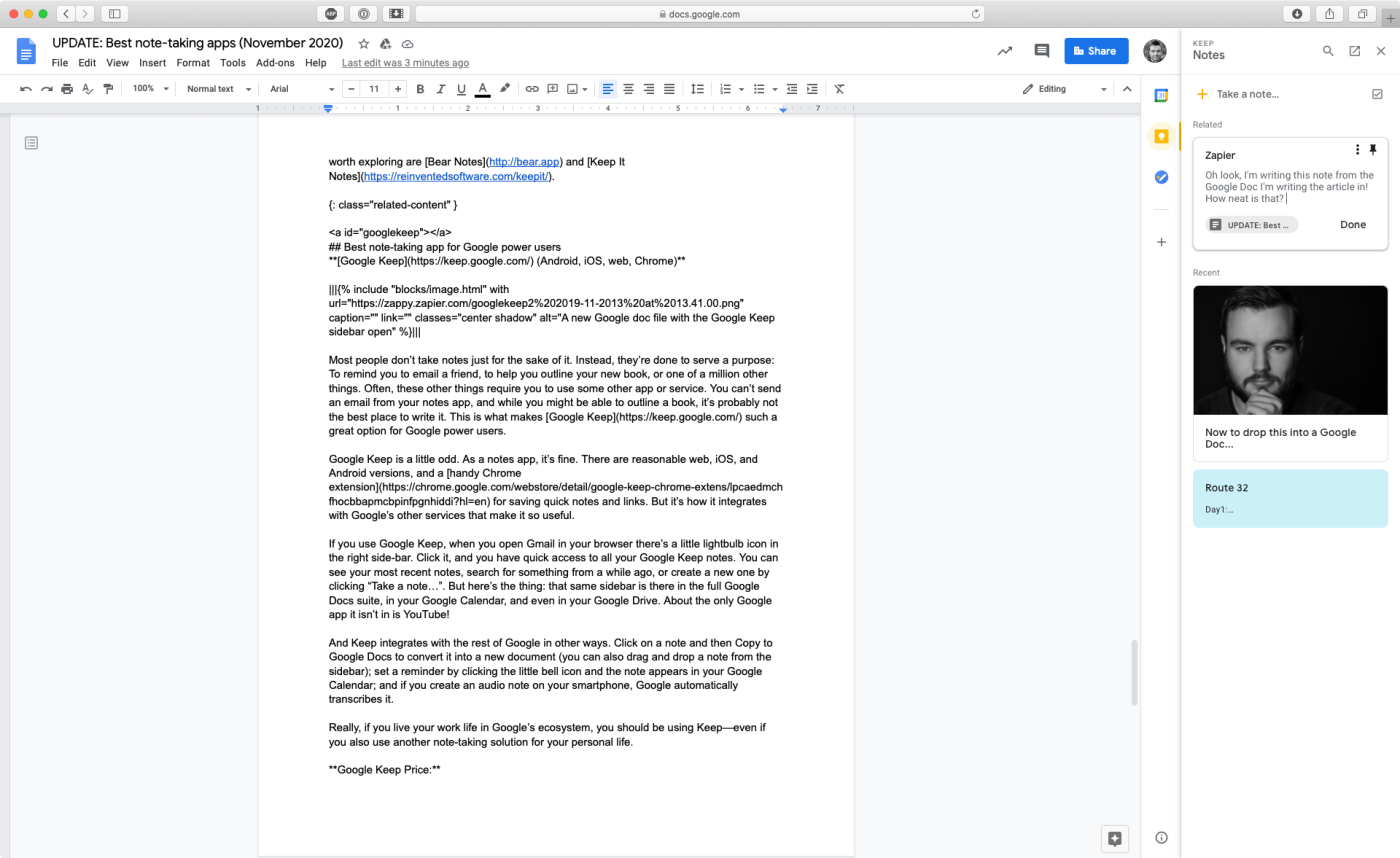
Most people don't take notes just for the sake of it. Instead, they're done to serve a purpose: to remind you to email a friend, to help you outline your new book, or one of a million other things. Often, these other things require you to use some other app or service. You can't send an email from your notes app, and while you might be able to outline a book, it's probably not the best place to write it. This is what makes Google Keep such a great option for Google power users.
Google Keep is a little odd. As a notes app, it's fine. There are reasonable web, iOS, and Android versions, and a handy Chrome extension for saving quick notes and links. But it's how it integrates with Google's other services that makes it so useful.
If you use Google Keep, when you open Gmail in your browser, there's a little lightbulb icon in the right sidebar. Click it, and you have quick access to all your Google Keep notes. You can see any notes related to the thing you're working on, your most recent notes, search for something from a while ago, or create a new one by clicking Take a note…. But here's the thing: that same sidebar is there in all of your Google Docs, in your Google Calendar, and even in your Google Drive. About the only Google app it isn't in is YouTube.
And Keep integrates with the rest of Google in other ways. Click on a note and then Copy to Google Docs to convert it into a new document (you can also drag and drop a note from the sidebar); set a reminder by clicking the little bell icon, and the note appears in your Google Calendar; and if you create an audio note on your smartphone, Google automatically transcribes it.
Really, if you live your work life in Google's ecosystem, you should be using Keep—even if you also use another note-taking solution for your personal life.
Google Keep Price: Free for 15GB of storage across all of Google apps; starts at $1.99/month for 100GB.
Best note-taking app for collaboration
Notion (Android, iOS, macOS, Windows, Web)
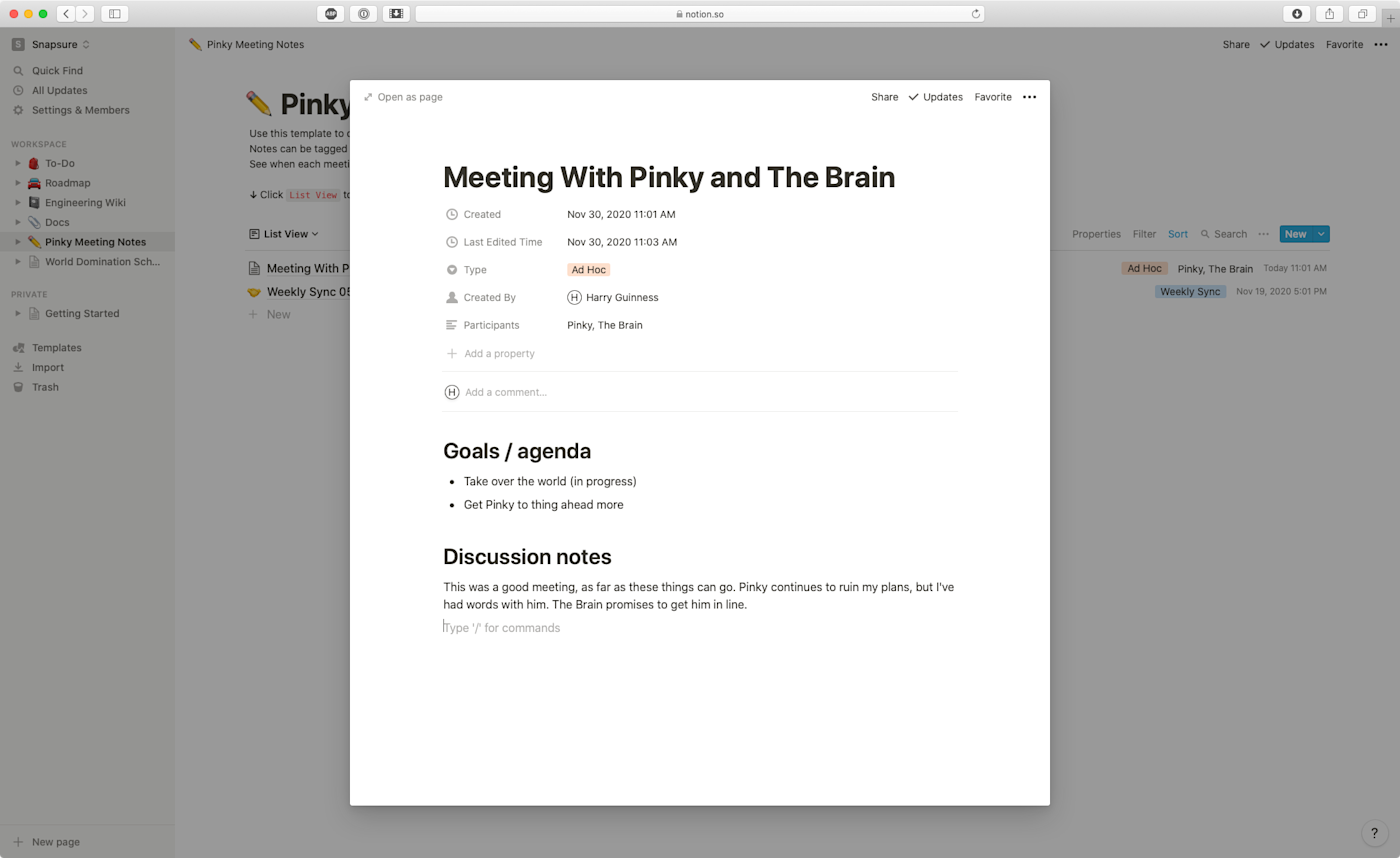
Note taking can be something you do for yourself, or something you do with and for others. All the apps we've looked at so far are mostly for taking notes for yourself. Sure, you can share and collaborate on notes and even notebooks, but their main features lie elsewhere. With Notion, collaboration on all aspects is built in from the start.
Notion is the only app on this list that skirts the provision of it being a note-taking app. It is, but because of its collaborative features, it can be so much more. It's basically three tools in one: a powerful notes app (which is why it's on this list), a task and project manager, and a reference wiki. How you combine those three things is up to you.
Each new document or note is called a page, and everything in Notion is referred to as a block. Blocks include basic elements like text, checklists, and headings, as well as media types like images, web bookmarks, video, audio, code snippets, and files. You can use as many blocks you want, in whatever combination, on every page. They're super quick to insert: just type / and scroll through the list. There are lots of templates built in too, so don't feel you have to customize absolutely everything when you're starting out. Just click on Templates in the sidebar, look through the options, and, when you find one you like, click Use This Template.
The sidebar is also how you browse all your pages. It's split into two sections: Workspace, which is all the pages you share with the rest of your team, and Private, where you can have your own notes. While collaboration is a big part of Notion, it's not forced on you. Everyone has their own section where they can work on things—and then move them out to the public areas for feedback and revision. It's a great way for an entire team to work together without getting in each other's way.
One thing to note: Notion bills itself as an Evernote competitor for personal users. It can be—but it's too much for most people. If you love the idea of Notion, go right ahead and try the free Personal Plan, but to us, it's really best as a team notes app.
Notion Price: Free for personal users; free trial for team users with a 1,000 block limit; from $10/month/user for teams with unlimited blocks.
Originally published in October 2015, this post was most recently updated in December 2020 by Harry Guinness. Emily Esposito and Jimmy Daly contributed to previous versions.
Get productivity tips delivered straight to your inbox
We'll email you 1/wk, and never share your information.
What App Does The Odd Ones Out Use To Draw
Source: https://zapier.com/blog/best-note-taking-apps/
Posted by: blanksenone1940.blogspot.com

0 Response to "What App Does The Odd Ones Out Use To Draw"
Post a Comment